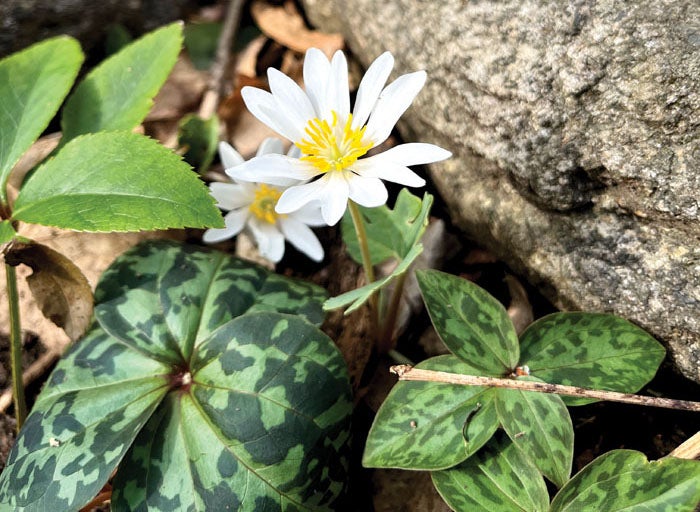Sarina Dellinger column: Spring ephemerals at Hurley Park
Published 12:00 am Saturday, April 9, 2022

- Bloodroot flower with trillium at base at Hurley Park.
By Sarina Dellinger
For the Salisbury Post
Despite the continuing fluctuation of temperatures, spring is here in Rowan County! Hurley Park has been aglow with blooms for a couple weeks. The magnolias and daffodils were short-lived due to the hard freeze, but plenty of the native and later blooming ornamental flowers are on display now.
One of the best, and often overlooked, parts of spring at Hurley Park are the woodland spring ephemerals. These resilient plants are native to the Southeast and can be found only before the trees fully leaf out in the spring. This is the nature of the spring ephemerals, meaning transitory or short-lived. These plants emerge, flower, and reproduce in a short window of the spring. For the rest of the year they wait underground for the next spring. Due to their sensitive nature and difficulty in reproduction it is not recommended to transplant them.
However, a jaunt through Hurley Park will satisfy your curiosity about these elusive plants. The best place to view the spring ephemerals is in the James B. Gascoigne Fern Glade and the John M. Riley Woodland Garden. Between these two gardens you will find trillium, bloodroot, mayapples, wild ginger, rue-anemone and more.
The trillium most prevalent is Trillium cuneatum or Little Sweet Betsy. This is a vigorously, but slow spreading trillium with mottled leaves and a purple “flower” with a sweet banana-like fragrance most prevalent on a warm spring day. If pollinated they produce a small fruit that is usually eaten and spread by ants. This spring ephemeral covers the forest floor in the John M. Riley Woodland Garden and hangs around until late May then it will senesce back underground until the following spring.
Alongside the Trillium cuneatum the bloodroot (Sanguinaria canadensis) can be found. When it begins to emerge the leaf is wrapped around the flower bud. This flower has a very short period to be viewed and will only open on sunny days and then close during the night. This helps protect the flower and pollen from being damaged during early spring weather events. The deeply lobed leaves will persist through early summer and are very noticeable once you know what you’re looking for.
The last plant I want to mention in detail is the mayapple (Podophyllum peltatum) which is looking spectacular in the James B. Gascoigne Fern Glade. This plant sends up stems with the leaves wrapped around it until it reaches its desired height then the umbrella-like leaves will unfurl. Each plant will produce one or two leaves depending on available nutrients and age of the plants. This plant is sensitive to frost damage which can be seen this year by the darker spots on the leaves. The white flowers, sparingly produced, are underneath the umbrella leaves and are pollinated by native bees. The common name, mayapple, comes from the apple-like fruit produced in May. It’s not very tasteful for humans, but box turtles and other small animals enjoy this fruit and help to spread its seeds.
Visit soon to see the cherry trees, tulips, phlox and more in bloom! We will highlight some of the spring ephemerals on our April Garden Tour at 10 a.m. on April 12.
If you have questions about Hurley Park, or want to know how to book events, please give us a call at 704-638-5298, or contact us on Facebook or Instagram @HurleyParkNC. To view a map or donate to Hurley Park, visit our website at salisburync.gov/hurleypark.
Sarina Dellinger is public garden manager for Salisbury Parks and Recreation.




